In February of this year, the offices of the service port of Portland, Maine moved out of the historic U.S. Custom House facing onto the harbor and Custom House Wharf, thus ending 140 years of continuous occupancy.
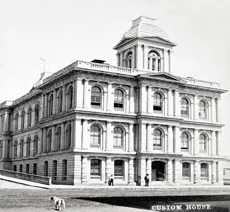
U.S. Custom House in Portland, Maine. Commercial Street facade facing the port and commercial wharves.
With a projected relocation at the end of 2012 from the historic customhouse in Port Townsend, Wash., this will narrow CBP's presence in designated historic structures to Norfolk, New Orleans, Baltimore, San Francisco, Charleston (S.C.), Ogdensburg, Savannah, Eastport (Me.), Port Huron (Mich.), New London (Conn.), Hilo and Honolulu in Hawaii, and the four remaining active customhouses on the island of Puerto Rico in San Juan, Ponce, Fajardo and Mayaguez. Since 9/11, CBP has also maintained a toehold of a few rooms in the imposing Alexander Hamilton U.S. Custom House on Bowling Green in Lower Manhattan.
CBP's departure from Portland's customhouse leads to looking back in history at the evolution of this port city that has been graced by the presence of a series of architecturally significant federal buildings.
Early Colonial Beginnings
By the mid-seventeenth century the British had settled in the area that today comprises Portland, South Portland, Westbrook and Cape Elizabeth. The British named the area Falmouth after the town and port on the River Fal on the southern coast of Cornwall in England. In 1658 the Lord Proprietor of Maine recognized Falmouth as the province's 7th town and in 1718 the town was incorporated by the Massachusetts General Court.
As early as 1730, a British naval officer was stationed in Falmouth to collect the customs. By 1758 the office of the (British) collector of customs was established. In 1775 the British customhouse was located at the corner of Middle and India Streets - this building was destroyed on October 18, 1775, when the fleet of the Royal Navy bombarded the town of Falmouth with incendiary shot as a means of completely destroying the town in retaliation for the townspeople's support of patriot activities in the early stages of rebellion which led to the American Revolution. News of the naval attack on Falmouth led the Second Continental Congress, then meeting in Philadelphia, to form a Continental Navy.
In 1786, the Colonists residing in what was then Falmouth Neck formed a separate town which they named Portland after the Isle of Portland off the coast of Dorset, England.
The United States Customs Collection District of Portland and Falmouth Established
At the time of its establishment as a town, and at the time of the ratification of the United States Constitution, Portland was in the State of Massachusetts. The Fifth Act of the First Congress of the United States was signed on July 31, 1789, which created an organization of customs collection districts in the eleven colonies that had ratified the Constitution and known as the United States Customs Service. The Portland and Falmouth customs collection district in the State of Massachusetts was established through this legislation, with Portland the port of entry and residence of the collector of customs, and North Yarmouth and Brunswick as ports of delivery. It was not until March 15, 1820, that the State of Maine was created and formally admitted to the Union as the twenty-third state.
Early Federal Presence in Portland
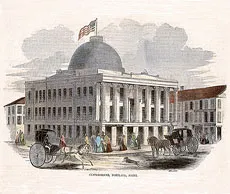
U.S. Custom House, Post Office and Court House at Middle and Exchange Streets served as the federal building from 1849-1853.
The Act of May 24, 1828, directed "the Secretary of the Treasury to cause a suitable site to be selected and purchased for a custom-house and warehouse, at Portland, in Maine, and to cause a safe and convenient building to be erected thereon, for the transaction of custom-house business, and for the safe keeping of the records thereof, and the property in the custody of the Government." A site was acquired on July 25, 1829, at a cost of $5,500., and a building was completed for the sum of $16,083.31. When the collector's offices were relocated in 1849, this building was remodeled and served as a customs warehouse.
Evidently the federal presence in Portland soon outgrew the 1828 building, and in 1849 the government purchased, for the sum of $149,000, the Portland Exchange building at Middle and Exchange Streets for use as a customhouse, post office and United States court.
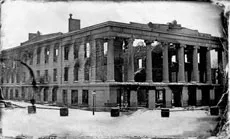
The federal building after the fire of January 8, 1853.
Both the "Exchange" customhouse and the 1828 former customhouse-cum-warehouse were destroyed in a conflagration on January 8, 1853. Following the fire, the collector's offices returned to the building on Fore Street that had served as the custom house from 1827-1831.
Growth of the Port of Portland in the Nineteenth Century
Portland's four-season sheltered port featured large in the ever increasing trade relationship with Montreal, Québec Province in Canada. Situated on the St. Lawrence River, Montreal's port was severely handicapped during the winter months when the river froze over. As Portland's four-season port was more easily accessible than Boston, Montreal utilized the protected American port to maintain trade with the British Isles and Europe.
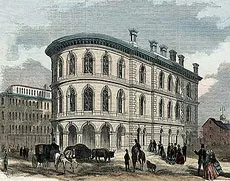
U.S. Custom House, Post Office and Court House at Middle and Exchange Streets Completed in 1857, the building was destroyed during the Great Portland Fire of July 4, 1866.
The relationship between Canada and Portland led to the rapid expansion of railroads to enhance the overland transport of goods and travelers. By 1851, the Atlantic and St. Lawrence Railroad was the first international line to cross the Northern Border at Island Pond, Vermont which was quickly transformed into a thriving railroad community, with the customs, and later the immigration inspectors located on the second floor of the railroad station. Huge passenger and freight stations were constructed in Portland, with the port area covered by a maze of tracks leading onto the ever increasing number of wharves along Commercial Street.
In 1853 the Department of the Treasury's Bureau of Construction was responsible for the design and construction of all federal buildings. Architect Ammi Burnham Young was responsible for drawing up plans for the new customhouse, post office and court house which would be erected on the site of the destroyed building at Middle and Exchange Streets.
A.B. Young's design for the new Portland federal building, which was completed in 1857, was not typical of his work, with a heavily fenestrated apsidal end facing down Exchange Street toward the busy port.
The Prince of Wales Visits Portland in 1860
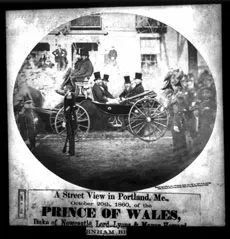
At eighteen, Albert Edward Prince of Wales was sent off on a tour of Canada and the U.S. by his parents Queen Victoria and the Prince Consort, in the hope of instilling some sense of responsibility and maturity in the problematical heir to the throne. The last stop on the Prince's American tour was in Boston, however, the port of Portland was deemed more agreeable for his departure because the British naval officers feared too many "tars" would jump ship in Boston's busy harbor!
The Prince entrained from Boston the morning of October 20, 1860, arriving in Portland in time for an elaborate luncheon held in his honor at the Prebble House, Throngs of the curious as well as ardent well-wishers lined the streets as the Prince's carriage proceeded to the luncheon and later to the Victoria Wharf, where he boarded a barge that conveyed him to the waiting H.M.S. "Hero" for the voyage to the port Plymouth on the southern coast of England - a harrowing trip that lasted 25 days and reduced His Royal Highness, his staff, officers and crew to eating rations from the ship's salt store.
Portland Burns Again on the 4th of July, 1866
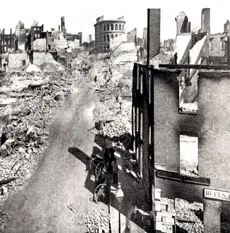
Fireworks set off during Portland's exuberant celebration of Independence Day ignited a boat builder's shop on Commercial Street that resulted in the Great 1866 Fire which destroyed a huge swath of the city. Ten thousand people were left homeless and Portland became a tent city The interior of Ammi Young's 1853 Custom House, Post Office and Court House was gutted and the granite walls left so blistered and unstable they were torn down the following year.
The aftermath of the 4th of July fire (photo at left) shows the devastation looking up Exchange Street toward the shell of the former U.S. Custom House, Post Office and Court House.
Customs operations were moved to the second floor of the Portland Savings Bank block on Exchange Street, which had survived the fire. The collector and his staff remained here until the new customhouse was ready for occupancy in October 1871.
A New "Fireproof" U.S. Custom House Rises from the Ashes
The frequency of massive conflagrations and the destruction of federal property led Supervising Architect of the Treasury Alfred Bult Mullett to consider the sites acquired for federal structures as well as the material utilized in construction to provide greater protection from the ever-present threat of fire. Mullett decreed that "fireproof" federal buildings should be located on single lots surrounded by streets in order to provide better protection from fire jumping and spreading from one structure to another.
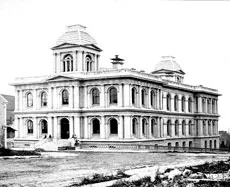
19th century view of the Fore Street facade of the customhouse. The public entrance led into the Customs business room.
In order to be closer to the port it was decided to site the new customhouse on land purchased in 1828 for the first federal customhouse that fronted on Fore Street between Pearl and Custom-House Streets. Additional land was procured in February 1867 for the sum of $35,000, which extended the site to include the entire block southeast to Commercial Street.
Mullett chose the Second Empire Style for the design of the customhouse, usually reserved for huge federal buildings sited in New York City, Philadelphia, St. Louis and Washington, D.C., reflected the importance of Portland in providing customs revenue to the Treasury and enabling brisk trade with Canada.
Mullet's design accommodated the steeply sloping site, which provided for the entrance to the Customs business room at the two-story end facing on Fore Street, and the entrance to the warehouse and appraiser's stores at the three-story end facing on Commercial Street and the wharves.
Construction got underway in 1868 and the building was completed in 1872, although the collector and his staff took up residency in October 1871.
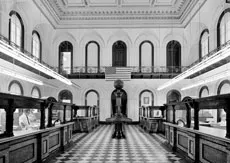
Modern view of the Customs business room with the sculptural writing podium in the center. (The fluorescent light fixtures are not original.)
Advancing age, inattentive maintenance and poorly executed repairs have rendered the historic structure uninhabitable. Invasive water damage from earlier faulty roof repairs and decayed grouting of the exterior granite walls resulted in large pieces of heavy decorative interior plasterwork to fall crashing to the floor and threatening the safety of occupants and visitors. In addition, GSA limited the port director's space assignment to the second floor which proved insufficient for current staffing.
Thus, early this year the port was permanently relocated to leased space in a commercial building in South Portland where there is ample parking available. GSA is currently making extensive repairs to the customhouse, and when completed other federal offices in the area will relocate there.
The beautiful old customhouse facing the inlet port off Casco Bay will live on as a much revered landmark in Portland - it just will no longer shelter the function for which it was built one hundred and forty years ago.

